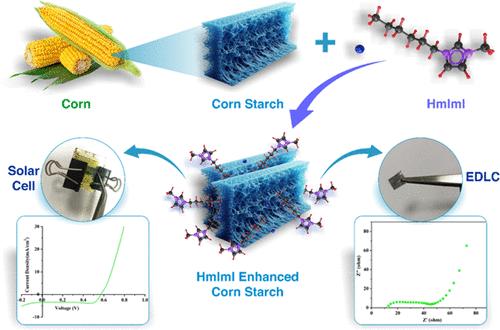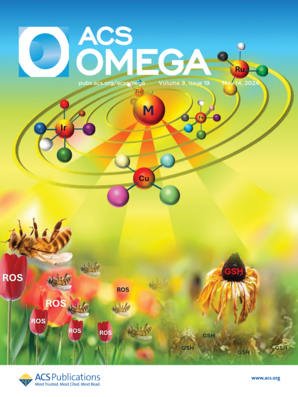使用离子液体掺杂固体生物聚合物电解质的稳定高效固态超级电容器和染料敏化太阳能电池
IF 3.7
3区 化学
Q2 CHEMISTRY, MULTIDISCIPLINARY
引用次数: 0
摘要
由于合成和不可生物降解的化合物正成为对环境的巨大挑战,因此利用天然可生物降解聚合物开发聚合物电解质以取代传统的水基电解质和合成聚合物基聚合物电解质引起了广泛的研究兴趣。本研究展示了一种掺杂玉米淀粉的高导电离子液体(1-己基-3-甲基碘化咪唑鎓)聚合物电解质的开发过程。采用简单的溶液浇注法制备生物聚合物基聚合物电解质,并通过不同的电学、结构和光电化学研究对其进行表征。根据离子电导率对制备的聚合物电解质进行了优化,结果显示离子电导率高达 1.90 × 10-3 S/cm。傅立叶变换红外光谱(FTIR)证实了络合和复合性质,而 X 射线衍射(XRD)和偏振光学显微镜(POM)证实了掺入离子液体(IL)后生物聚合物电解质结晶度的降低。热和光电化学研究进一步证实,合成材料在 200 °C 以上非常稳定,并显示出 3.91 V 的宽电化学窗口。利用导电率最高的玉米淀粉聚合物电解质制作了双电层电容器(EDLC)和染料敏化太阳能电池(DSSC)。所制备的双电层电容器和染料敏化太阳能电池在一太阳条件下的平均比电容分别为 130 F/g,效率为 1.73%。本文章由计算机程序翻译,如有差异,请以英文原文为准。

Stable Efficient Solid-State Supercapacitors and Dye-Sensitized Solar Cells Using Ionic Liquid-Doped Solid Biopolymer Electrolyte
As synthetic and nonbiodegradable compounds are becoming a great challenge for the environment, developing polymer electrolytes using naturally occurring biodegradable polymers has drawn considerable research interest to replace traditional aqueous electrolytes and synthetic polymer-based polymer electrolytes. This study shows the development of a highly conducting ionic liquid (1-hexyl-3-methylimidazolium iodide)-doped corn starch-based polymer electrolyte. A simple solution cast method is used to prepare biopolymer-based polymer electrolytes and characterized using different electrical, structural, and photoelectrochemical studies. Prepared polymer electrolytes are optimized based on ionic conductivity, which shows an ionic conductivity as high as 1.90 × 10–3 S/cm. Fourier transform infrared spectroscopy (FTIR) confirms the complexation and composite nature, while X-ray diffraction (XRD) and polarized optical microscopy (POM) affirm the reduction of crystallinity in biopolymer electrolytes after doping with ionic liquid (IL). Thermal and photoelectrochemical studies further affirm that synthesized material is well stable above 200 °C and shows a wide electrochemical window of 3.91 V. The ionic transference number measurement (tion) confirms the predominance of ionic charge carriers in the present system. An electric double-layer capacitor (EDLC) and a dye-sensitized solar cell (DSSC) were fabricated by using the highest conducting corn starch polymer electrolyte. The fabricated EDLC and DSSC delivered an average specific capacitance of 130 F/g and an efficiency of 1.73% in one sun condition, respectively.
求助全文
通过发布文献求助,成功后即可免费获取论文全文。
去求助
来源期刊

ACS Omega
Chemical Engineering-General Chemical Engineering
CiteScore
6.60
自引率
4.90%
发文量
3945
审稿时长
2.4 months
期刊介绍:
ACS Omega is an open-access global publication for scientific articles that describe new findings in chemistry and interfacing areas of science, without any perceived evaluation of immediate impact.
 求助内容:
求助内容: 应助结果提醒方式:
应助结果提醒方式:


